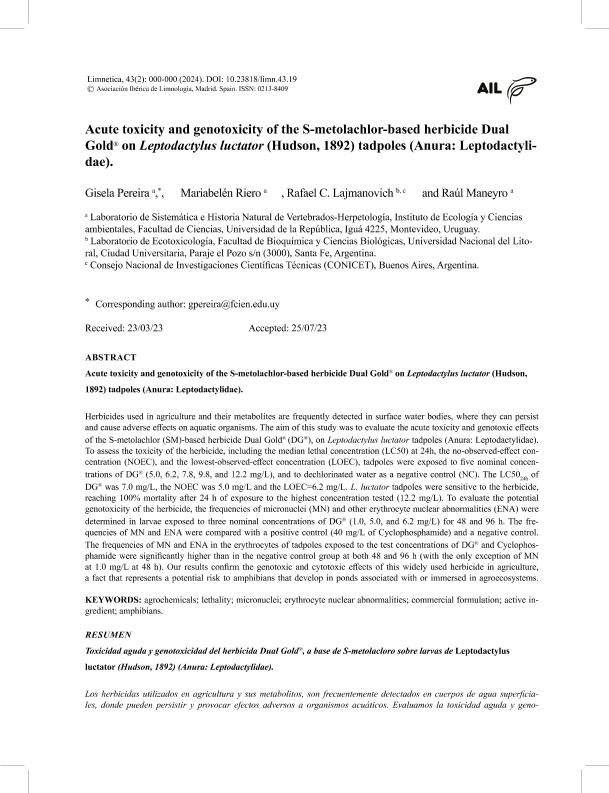Artículo
Herbicides used in agriculture and their metabolites are frequently detected in surface water bodies, where they can persist and cause adverse effects on aquatic organisms. The aim of this study was to evaluate the acute toxicity and genotoxic effects of the S-metolachlor (SM)-based herbicide Dual Gold® (DG®), on Leptodactylus luctator tadpoles (Anura: Leptodactylidae). To assess the toxicity of the herbicide, including the median lethal concentration (LC50) at 24h, the no-observed-effect con-centration (NOEC), and the lowest-observed-effect concentration (LOEC), tadpoles were exposed to five nominal concen-trations of DG® (5.0, 6.2, 7.8, 9.8, and 12.2 mg/L), and to dechlorinated water as a negative control (NC). The LC5024h of DG® was 7.0 mg/L, the NOEC was 5.0 mg/L and the LOEC=6.2 mg/L. L. luctator tadpoles were sensitive to the herbicide, reaching 100% mortality after 24 h of exposure to the highest concentration tested (12.2 mg/L). To evaluate the potential genotoxicity of the herbicide, the frequencies of micronuclei (MN) and other erythrocyte nuclear abnormalities (ENA) were determined in larvae exposed to three nominal concentrations of DG® (1.0, 5.0, and 6.2 mg/L) for 48 and 96 h. The fre-quencies of MN and ENA were compared with a positive control (40 mg/L of Cyclophosphamide) and a negative control. The frequencies of MN and ENA in the erythrocytes of tadpoles exposed to the test concentrations of DG® and Cyclophos-phamide were significantly higher than in the negative control group at both 48 and 96 h (with the only exception of MN at 1.0 mg/L at 48 h). Our results confirm the genotoxic and cytotoxic effects of this widely used herbicide in agriculture, a fact that represents a potential risk to amphibians that develop in ponds associated with or immersed in agroecosystems. Los herbicidas utilizados en agricultura y sus metabolitos, son frecuentemente detectados en cuerpos de agua superficiales, donde pueden persistir y provocar efectos adversos a organismos acuáticos. Evaluamos la toxicidad aguda y geno toxicidad del herbicida Dual Gold® (DG®), a base de S-metolacloro (SM), sobre larvas de Leptodactylus luctator (Anura: Leptodactylidae). Para determinar la toxicidad del herbicida, incluida la concentración letal media (CL50) 24h, la concentración sin efecto observado (NOEC); y con efecto observado más baja (LOEC); las larvas fueron expuestas a cinco concentraciones nominales de DG® (5.0; 6.2; 7.8; 9.8; y 12.2 mg/L); y a un control negativo con agua declorada. El valor de CL5024h para DG® fue de 7.0 mg/L (NOEC=5.0 mg/L; LOEC=6.2 mg/L). Las larvas fueron sensibles al herbicida, alcanzando el 100% de mortalidad a las 24h, en la concentración más alta testada (12.2 mg/L). Para estudiar el potencial genotóxico del herbicida, se determinó la frecuencia de micronúcleos (MN) y de otras aberraciones nucleares de los eritrocitos (ENA), en larvas expuestas a tres concentraciones de DG® (1.0, 5.0 y 6.2 mg/L), durante 48 y 96h; y las mismas se compararon con un control positivo (40 mg/L de Ciclofosfamida) y negativo. Las frecuencias de MN y ENA en los eritrocitos de larvas expuestas a las concentraciones de prueba de DG® y Ciclofosfamida fueron significativamente mayores que en el grupo control negativo, a las 48 y 96 h (con la única excepción de MN a 1.0 mg/L a las 48 h). Nuestros resultados comprueban los efectos genotóxicos y citotóxicos de este herbicida ampliamente utilizado en la agricultura, lo cual representa un riesgo potencial para los anfibios que se desarrollan en cuerpos de agua asociados o inmersos en agroecosistemas.
Acute toxicity and genotoxicity of the S-metolachlor-based herbicide Dual Gold® on Leptodactylus luctator (Hudson, 1892) tadpoles (Anura: Leptodactyli- dae)
Título:
Toxicidad aguda y genotoxicidad del herbicida Dual Gold®, a base de S-metolacloro sobre larvas de Leptodactylus luctator (Hudson, 1892) (Anura: Leptodactylidae)
Fecha de publicación:
02/2024
Editorial:
Asociación Española de Limnología
Revista:
Limnetica
ISSN:
0213-8409
Idioma:
Inglés
Tipo de recurso:
Artículo publicado
Clasificación temática:
Resumen
Archivos asociados
Licencia
Identificadores
Colecciones
Articulos(CCT - SANTA FE)
Articulos de CTRO.CIENTIFICO TECNOL.CONICET - SANTA FE
Articulos de CTRO.CIENTIFICO TECNOL.CONICET - SANTA FE
Citación
Pereira, Gisela; Riero, Mariabelén; Lajmanovich, Rafael Carlos; Maneiro, Raul; Acute toxicity and genotoxicity of the S-metolachlor-based herbicide Dual Gold® on Leptodactylus luctator (Hudson, 1892) tadpoles (Anura: Leptodactyli- dae); Asociación Española de Limnología; Limnetica; 2-2024; 1-17
Compartir
Altmétricas




